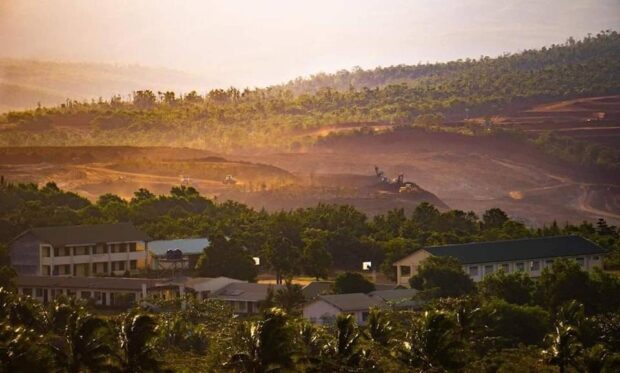
EXTRACTION SITE | Mining operations are just at the doorstep of Homonhon National High School located in Barangay Casuguran on the island, which is under the jurisdiction of Guiuan town in Eastern Samar. This photo is taken on Oct. 25, 2023. (Photo from the Save Homonhon Movement)
TACLOBAN CITY, Leyte, Philippines — The mayor of the coastal municipality of Guiuan in Eastern Samar province has defended the mining operations in the town, saying these have brought many benefits not only to the government but also to its residents.
Mayor Annaliza Gonzales-Kwan said mining has resulted in the employment of 2,300 residents from the mainland and generated income and taxes for the government.
Mining companies, she said, also became partners of the local government in the social development projects that benefited the villagers.
Gonzales-Kwan said she was disappointed that those opposing the mining operations make it appear that the locality was in “bad shape.”
“We, the people of Guiuan, are quiet because we know the truth. It is the people from the outside who are creating much noise,” the town mayor said via Viber on Sunday.
“I am for responsible mining. I understand the issue of the environment but if people have no jobs, the rest of the environment will be destroyed: illegal fishing, logging, etcetera. Now that there is mining in Homonhon (an island belonging to Guiuan), some people from [mainland] Guiuan are already working there,” Gonzales-Kwan said.
Address the ‘bigger problem’
The mayor had pointed to an article that appeared on Inquirer.net on Saturday where the Mines and Geosciences Bureau in Eastern Visayas (MGB-8) said mining activities in Eastern Visayas resulted in P182.62 million in income for the national government in terms of the excise tax paid by the mining operators last year.
Glen Noble, regional director of the MGB, said the mining sector in the region contributed to the economy in the region, aside from providing employment opportunities for locals.
These mining companies are located on Homonhon Island, which are extracting nickel and chromite deposits.
At present, four mining companies are operating on the island: Emir Mineral Resources Corp., Chromite King Inc., Nickelace Inc., and Mt. Sinai Mining Exploration and Development Corp.
These companies have a combined workforce of 1,549 who are mostly local residents.
Gonzales-Kwan said the economic benefits of mining outweigh the emotional noise being bandied around.
“Poverty is the bigger problem,” she said.
The mayor claimed that the photo that appeared in the Inquirer.net story was deceiving, saying what appeared to be pits were silting ponds of the mining company where water from mining operations was collected until all the sediments were settled.
“The photo in your article is the silting pond of a mining company. The photos seem to be enhanced and enlarged. That is not the true picture of Homonhon, otherwise, the people of Homonhon will have no more land to live if that is true,” Gonzales-Kwan said.
“There are eight barangays with more or less 4,000 people. Homonhon’s land area is around 10,000 hectares and only less than 10 percent is being mined,” she added.
Land development plan
Gonzales-Kwan said mining companies have their land development plan to restore the mined area.
“When ore is taken out of the surface, it is now fit for agriculture activities,” she said.
“My job is to give jobs to my people and to live a better life. We are working on a comprehensive environmental development plan for Homonhon Island which will be funded by the social development management program fund of the mining companies which is 1 percent of its operating cost,” she added.
But the anti-mining group Homonhon Environmental Advocates and Rights Defender Inc. (Heard), said that no amount would compensate for the destruction caused by the mining operations on the island, where Portuguese explorer Ferdinand Magellan landed in 1521.
“No amount is worthy enough for the damages, bad effects, and destruction the mining has brought to the island,” said Daipen Montes, a board director of Heard.